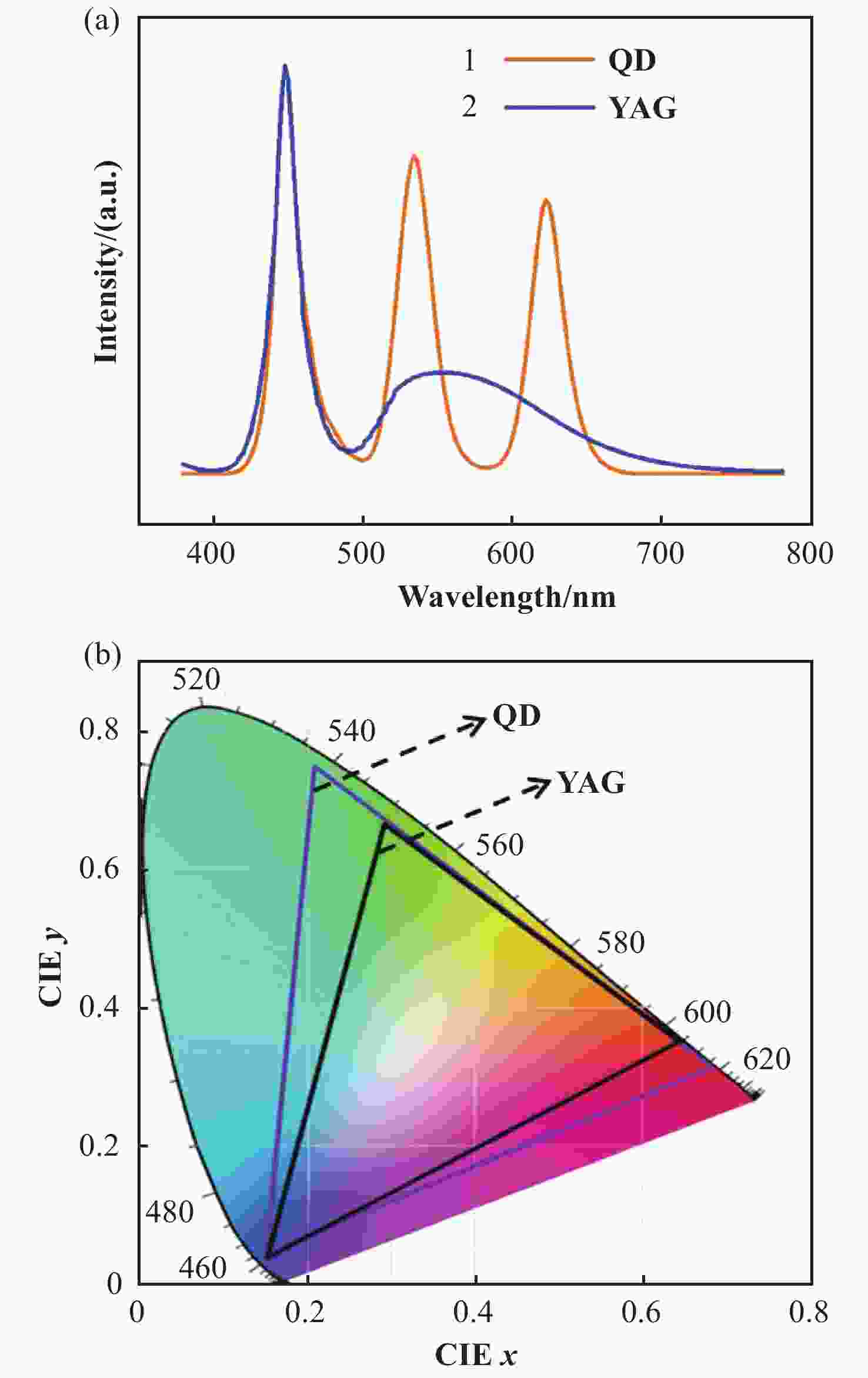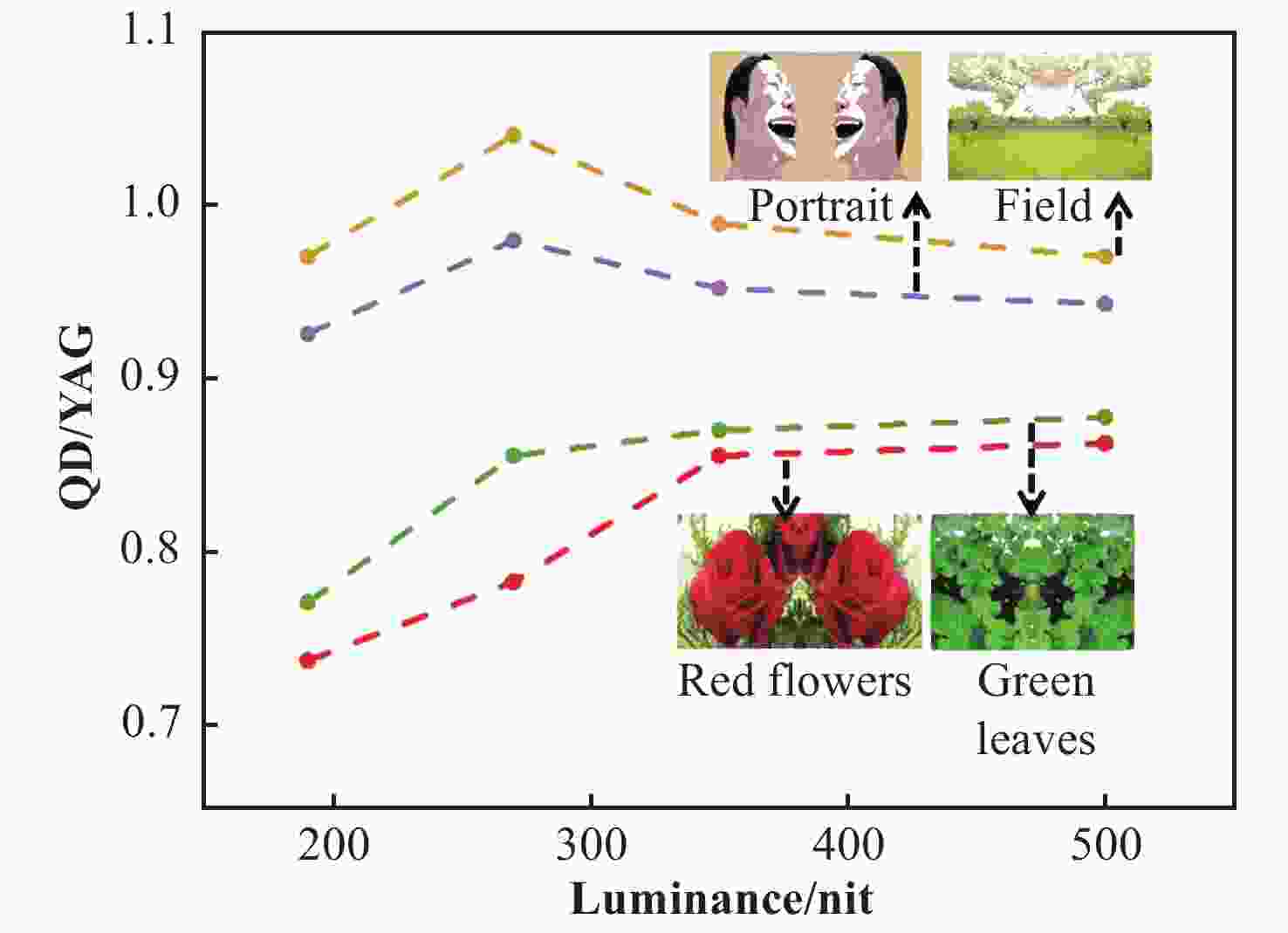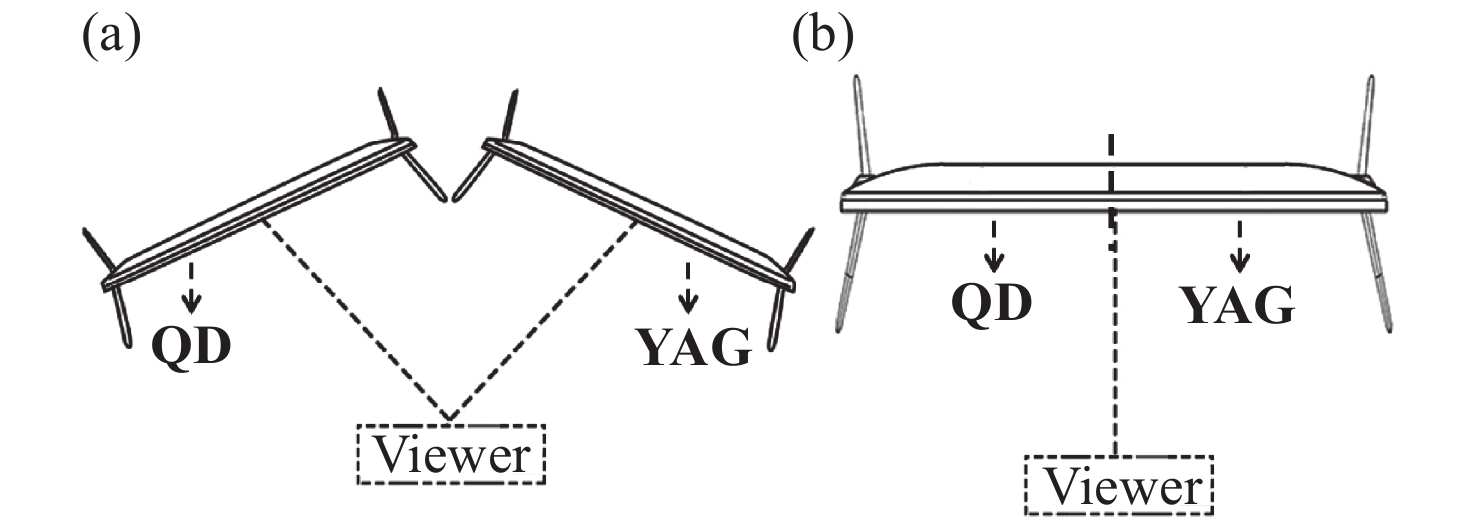Illustrating the Helmholtz-Kohlrausch effect of quantum dots enhanced LCD through a comparative study
doi: 10.37188/CO.2021-0058
-
摘要: 亥姆霍兹-科尔劳施效应(简称H-K效应)指的是人眼对色光的感知亮度随着色纯度的增加而提升的现象。量子点背光技术可显著提升液晶显示的色域和视觉感知亮度,已经在众多显示产品中开始应用。本论文通过观看者亮度感知实验,对比了YAG荧光粉白光LED背光电视(YAG电视)和量子点背光电视(量子点电视)的H-K效应差异,根据Kaiser模型与Nayatani模型分析纯色实验的测试结果,并通过彩色实验探究了显示器的色域对感知亮度与主观偏好的影响。实验结果表明:量子点电视具有更为显著的H-K效应,视觉感知亮度明显高于传统YAG电视;在同样的感知亮度下,量子点电视的纯色R、G的物理亮度仅为YAG电视的75%、86%;鲜艳彩色画面的物理亮度为YAG电视的74%~88%;在相同感知亮度下,高色域的量子点电视更受欢迎,并且喜好趋势将随着亮度的增加而增加。上述结果对于健康显示的发展具有重要指导意义。Abstract: Helmholtz-Kohlrausch effect (H-K effect) describes the influence of color purity on the perceived brightness of a colored object. Quantum dots (QD) based backlights can enhance the color quality of Liquid Crystal Display (LCD) with improved perceived brightness due to the well-known H-K effect. However, the H-K effect of QD embedded TVs (also known as QLED TV) has not been fully demonstrated. In this paper, we investigated the H-K effect of QLED TVs through a comparative study between QLED backlights and YAG-LED backlights. By comparing the viewers’ experimental results with the Kaiser and Nayatani model, we demonstrate that a QLED TV shows significant H-K effect. To achieve the same perceived brightness with YAG-LED TV, the physical brightness of QLED TV was greatly decreased to 75% for pure red, 86% for pure green, and 74%-88% for bright colorful images. Moreover, QLED TVs are strongly preferred over YAG-LED TVs even when both QLED TV and YAG-LED TV show the same perceived brightness. The results imply the bright future of QLED TVs toward healthly displays.
-
Key words:
- QLED TV /
- Helmholtz-Kohlrausch effect /
- perceived brightness /
- display /
- colority
-
表 1 Key parameters of test environment
Table 1. Key parameters of test environment
Experimental environment Parameters Viewing distance 2 m Viewer position Horizontal midline Ambient light Illuminance 105~156 lx Color temperature 5500 K Source channel HDMI Luminance 200~500 nit -
[1] ERDEM T, DEMIR H V. Color science of nanocrystal quantum dots for lighting and displays[J]. Nanophotonics, 2013, 2(1): 57-81. doi: 10.1515/nanoph-2012-0031 [2] SMITH A R. Color gamut transform pairs[J]. ACM Siggraph Computer Graphics, 1978, 12(3): 12-19. doi: 10.1145/965139.807361 [3] CHEN H W, ZHU R D, HE J, et al. Going beyond the limit of an LCD's color gamut[J]. Light:Science &Applications, 2017, 6(9): e17043. [4] CHEN H W, LEE J H, LIN B Y, et al. Liquid crystal display and organic light-emitting diode display: present status and future perspectives[J]. Light:Science &Applications, 2018, 7(3): 17168. [5] OWEN J, BRUS L. Chemical synthesis and luminescence applications of colloidal semiconductor quantum dots[J]. Journal of the American Chemical Society, 2017, 139(32): 10939-10943. doi: 10.1021/jacs.7b05267 [6] SHU Y F, LIN X, QIN H Y, et al. Quantum dots for display applications[J]. Angewandte Chemie International Edition, 2020, 59(50): 22312-22323. doi: 10.1002/anie.202004857 [7] CHANG S, BAI Z L, ZHONG H ZH. In situ fabricated perovskite nanocrystals: a revolution in optical materials[J]. Advanced Optical Materials, 2018, 6(18): 1800380. doi: 10.1002/adom.201800380 [8] SHIRASAKI Y, SUPRAN G J, BAWENDI M G, et al. Emergence of colloidal quantum-dot light-emitting technologies[J]. Nature Photonics, 2013, 7(1): 13-23. doi: 10.1038/nphoton.2012.328 [9] KAZLAS P T, ZHOU Z Q, STEVENSON M, et al. 32.4: quantum dot light emitting diodes for full-color active-matrix displays[J]. SID Symposium Digest of Technical Papers, 2010, 41(1): 473-476. doi: 10.1889/1.3500495 [10] JANG E, JUN S, JANG H, et al. White-light-emitting diodes with quantum dot color converters for display backlights[J]. Advanced Materials, 2010, 22(28): 3076-3080. doi: 10.1002/adma.201000525 [11] COE-SULLIVAN S, ZHOU ZH Q, NIU Y H, et al. 12.2: invited paper: quantum dot light emitting diodes for near-to-eye and direct view display applications [J]. SID Symposium Digest of Technical Papers, 2011, 42(1): 135-138. doi: 10.1889/1.3621094 [12] GUAN X Y, WANG H ZH, SHEN H B, et al. Research progress of quantum dot light-emitting devices for display application[J]. Chinese Journal of Liquid Crystals and Displays, 2021, 36(1): 176-186. (in Chinese) doi: 10.37188/CJLCD.2020-0263 [13] LI J J, NIE X M, ZHEN W, et al. New developments and comparisons in display technology[J]. Chinese Journal of Liquid Crystals and Displays, 2018, 33(1): 74-84. (in Chinese) doi: 10.3788/YJYXS20183301.0074 [14] BOURZAC K. Quantum dots go on display: adoption by TV makers could expand the market for light-emitting nanocrystals[J]. Nature, 2013, 493(7432): 283. doi: 10.1038/493283a [15] CHOI M K, YANG J, HYEON T, et al. Flexible quantum dot light-emitting diodes for next-generation displays[J]. npj Flexible Electronics, 2018, 2(1): 10. doi: 10.1038/s41528-018-0023-3 [16] JI H L, ZHOU Q CH, PAN J, et al. Advances and prospects in quantum dots based backlights[J]. Chinese Optics, 2017, 10(5): 666-680. (in Chinese) doi: 10.3788/co.20171005.0666 [17] YE Y, YU J H, LIN SH Y, et al. Progress of quantum dot backlight technology[J]. Chinese Optics, 2020, 13(1): 14-27. (in Chinese) doi: 10.3788/co.20201301.0014 [18] DONOFRIO R L. Review paper: the helmholtz-kohlrausch effect[J]. Journal of the Society for Information Display, 2011, 19(10): 658-664. doi: 10.1889/JSID19.10.658 [19] SHIZUME T, OHASHI G, TAKAMATSU H, et al. Estimation of the Helmholtz-Kohlrausch effect for natural images[J]. Journal of the Society for Information Display, 2014, 22(11): 588-596. doi: 10.1002/jsid.291 [20] CHEN H W, HE J, WU S T. Recent advances on quantum-dot-enhanced liquid-crystal displays[J]. IEEE Journal of Selected Topics in Quantum Electronics, 2017, 23(5): 1900611. [21] TSUJIMURA T, ZHU W, MIZUKOSHI S, et al. 8.1: invited paper: advancements and outlook of high performance active-matrix OLED displays[J]. SID Symposium Digest of Technical Papers, 2007, 38(1): 84-88. doi: 10.1889/1.2785232 [22] LIAO S F, CHOU H Y, YANG T H, et al. 20.1: perceived brightness of LED projector[J]. SID Symposium Digest of Technical Papers, 2009, 40(1): 262-264. doi: 10.1889/1.3256758 [23] LIAO S F, YANG T H, LEE C C, et al. 18.4: color perception in LED projectors[J]. SID Symposium Digest of Technical Papers, 2011, 42(1): 229-231. doi: 10.1889/1.3621280 [24] MANDERS J R, QIAN L, TITOV A, et al. High efficiency and ultra-wide color gamut quantum dot LEDs for next generation displays[J]. Journal of the Society for Information Display, 2015, 23(11): 523-528. doi: 10.1002/jsid.393 [25] LUO ZH Y, XU D M, WU S T. Emerging quantum-dots-enhanced LCDs[J]. Journal of Display Technology, 2014, 10(7): 526-539. doi: 10.1109/JDT.2014.2325218 [26] CORNSWEET T N, TELLER D Y. Relation of increment thresholds to brightness and luminance[J]. Journal of the Optical Society of America, 1965, 55(10): 1303-1308. doi: 10.1364/JOSA.55.001303 [27] UCHIKAWA K, UCHIKAWA H, KAISER P K. Equating colors for saturation and brightness: the relationship to luminance[J]. Journal of the Optical Society of America, 1982, 72(9): 1219-1224. doi: 10.1364/JOSA.72.001219 [28] UCHIKAWA K, UCHIKAWA H, KAISER P K. Luminance and saturation of equally bright colors[J]. Color Research &Application, 1984, 9(1): 5-14. [29] KAISER P K. Sensation luminance: a new name to distinguish CIE luminance from luminance dependent on an individual's spectral sensitivity[J]. Vision Research, 1988, 28(3): 455-456. doi: 10.1016/0042-6989(88)90186-1 [30] KAISER P K. Models of heterochromatic brightness matching[J]. CIE Journal, 1986, 5: 57-59. [31] NAYATANI Y, UMEMURA Y, SOBAGAKI H, et al. Lightness perception of chromatic object colors[J]. Color Research &Application, 1991, 16(1): 16-25. [32] NAYATANI Y. Simple estimation methods for the Helmholtz-Kohlrausch effect[J]. Color Research &Application, 1997, 22(6): 385-401. [33] State Administration of Radio, Film, and Television. GY/T 134-1998 The method for subjective assessment of the quality of digital television picture[S]. Institute of Standardization Planning, State Administration of Radio, Film and Television, 1999. (in Chinese) [34] KASHANI A H, ZIMMER-GALLER I E, SHAH S M, et al. Retinal thickness analysis by race, gender, and age using stratus OCT[J]. American Journal of Ophthalmology, 2010, 149(3): 496-502. doi: 10.1016/j.ajo.2009.09.025 [35] ZHANG P Q, WANG D, LV ZH H, et al. Review of determinants of healthy display[J]. Chinese Journal of Liquid Crystals and Displays, 2020, 35(9): 981-990. (in Chinese) doi: 10.37188/YJYXS20203509.0981 [36] SHI D M, YANG B. Current development and trend of quantum dot materials and display technology[J]. Science and Technology in China, 2017(12): 8-10. (in Chinese) doi: 10.3969/j.issn.1673-5129.2017.12.004 [37] LYU M, ZHANG L, ZHANG Y,et al. Strategies for improving the stability of quantum dots light-emitting diodes[J]. Chinese Optics, 2021, 14(1): 117-134. (in Chinese) -






 下载:
下载:






